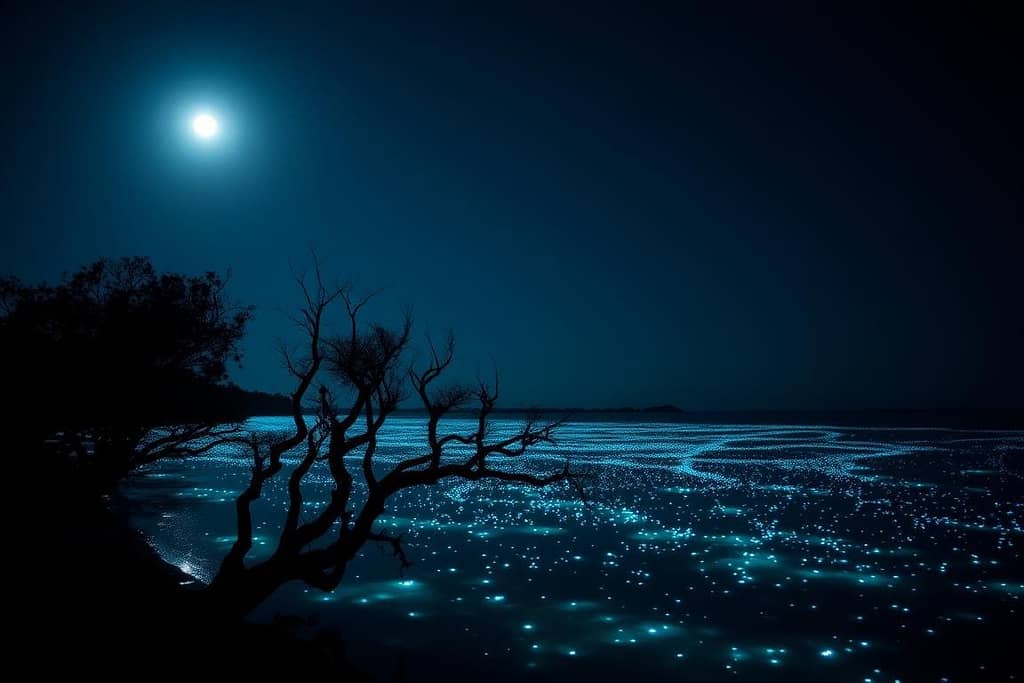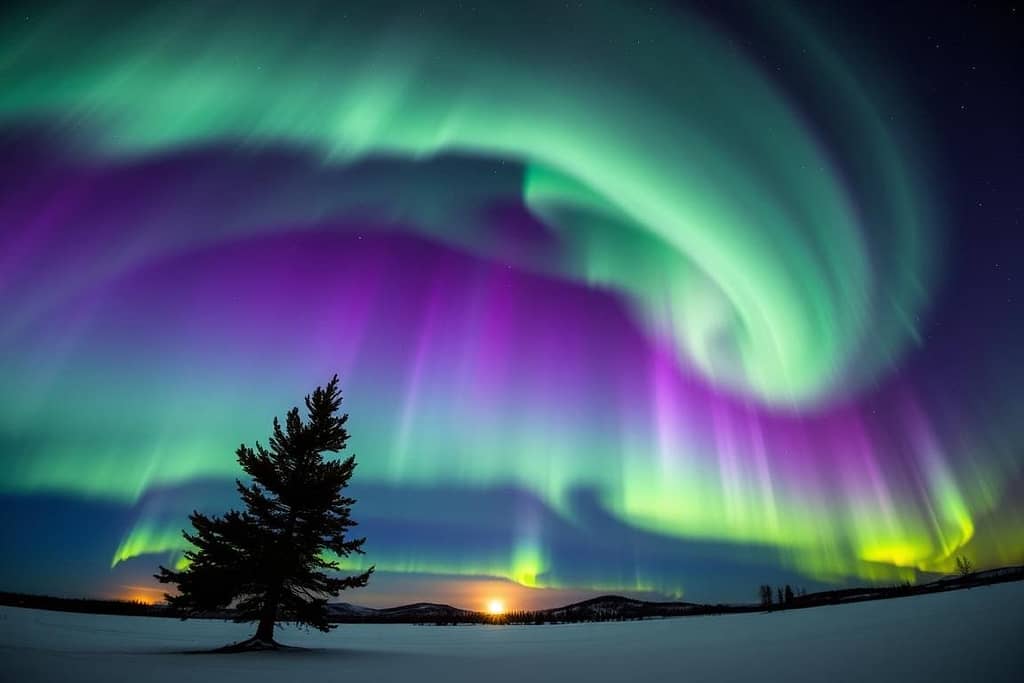The World’s Strangest Natural Phenomena
Imagine a world where lakes turn blood-red, stones glide across desert floors, and landscapes defy explanation. Our planet is full of geological wonders that challenge our understanding of nature. For example, frozen methane bubbles in Canadian lakes can reach up to 900 meters across. In California’s Racetrack Playa, mysterious stones sail across the ground. These events show Earth is a treasure trove of unusual weather events. They will blow your mind.
In this journey through The World’s Strangest Natural Phenomena, we’ll explore landscapes and events that seem like science fiction. You’ll see incredible places where nature shows its most unexpected and breathtaking sides. These places push the limits of what we thought was possible. Get ready to see geological wonders that will change how you see our incredible planet. Each place has a unique story of natural forces at work. They reveal the extraordinary complexity and mystery of Earth’s most remarkable environments.
Key Takeaways
- Discover extraordinary natural phenomena from around the globe
- Explore geological wonders that challenge scientific understanding
- Learn about rare and unexpected environmental conditions
- Understand the science behind bizarre natural events
- Appreciate the incredible diversity of Earth’s landscapes
The Mysterious Sailing Stones of Death Valley
Imagine a place where rocks move on their own, sliding across the desert. This is Racetrack Playa in Death Valley National Park. It’s a spot filled with one of the world’s most fascinating mysteries.
For years, scientists and explorers have been baffled by these rocks. They can weigh up to 36 kg and leave trails on the dry lake bed. It looks like magic.
Unveiling the Sailing Stone Mystery
Researchers tried to figure out how these stones moved for decades. But it wasn’t until 2014 that they found the answer.
- Stones range from 15 to 46 cm in diameter
- Movements occur only a few times per year
- Tracks can last 3 to 4 years
The Scientific Explanation
The mystery was solved by a rare winter event. Rain and cold temperatures create a thin ice sheet. Then, light winds of 4-5 meters per second push the stones.
| Movement Characteristic | Details |
|---|---|
| Maximum Distance | 224 meters |
| Movement Speed | 5-15 feet per minute |
| Typical Movement Duration | 15 minutes or less |
This event is so rare, it happens only a few times a year. On December 20, 2013, over 60 rocks moved at once. This gave scientists a big breakthrough into these mysterious natural occurrences.
“Nature’s most fascinating mysteries often have the most elegant scientific explanations.” – Death Valley Research Team
The Incredible Bioluminescence of Mosquito Bay
Imagine swimming in a sea of living light. Mosquito Bay in Puerto Rico offers this magical experience. It’s a world-renowned spot for witnessing an extraordinary ecosystem that glows with blue-green light.
The Science Behind the Magical Glow
Under Mosquito Bay’s surface, a microscopic light show happens. Up to 720,000 tiny dinoflagellates live in each gallon of water. These tiny creatures light up the water with a chemical reaction, creating a blue-green glow.
- Contains up to 160,000 dinoflagellates per liter of water
- Declared the brightest bioluminescent bay by Guinness World Records in 2008
- Unique ecosystem supported by surrounding mangrove trees
When to Experience the Luminous Wonder
Timing is key when exploring this bioluminescent marvel. The bay shines brightest during the new moon phase. This is when darkness sets the stage for nature’s light show. Visitors can see enough light to read a book, making it a memorable experience.
Mosquito Bay is special, but it’s not the only one. Puerto Rico has three bioluminescent bays, with Mosquito Bay being the brightest. Its shallow entrance and protected environment keep its ecosystem unique. This ensures visitors can enjoy this natural wonder for years to come.
The Breathtaking Northern Lights
Imagine standing under a dark sky when suddenly, a magical dance of colors erupts above. The Northern Lights are a mesmerizing sight, turning ordinary nights into unforgettable moments.
The Cosmic Light Show Explained
These colorful lights aren’t just magic – they’re a natural wonder. They happen when solar particles meet Earth’s magnetic field. Seen about 100 kilometers up, they are a stunning sight.
- Best viewed between 6 PM and 1 AM
- Most frequent from September to late March
- Influenced by solar activity and magnetic interactions
Where to Witness Nature’s Light Performance
Want to see these amazing lights? Northern Norway is the best place. Places like Lofoten and Tromsø offer great views, right in the auroral oval.
Other great spots include:
- Iceland
- Alaska
- Northern Canada
- Greenland
Each spot gives a different view of these incredible celestial displays. They promise an unforgettable experience with nature’s wonders.
The Most Isolated Tribes in the World: Hidden From Civilization
The Surreal Blood Falls in Antarctica
Antarctica is home to a remarkable sight: Blood Falls. It’s a red waterfall on a white glacier. This contrast is both striking and puzzling.
Blood Falls is in the McMurdo Dry Valleys. It’s a weather event unlike any other. The falls come from Taylor Glacier, showing nature’s most surprising sights.
The Mysterious Red Water Phenomenon
So, why is Blood Falls red? Scientists found an interesting reason:
- A subglacial lake trapped beneath Taylor Glacier for nearly two million years
- High iron content in the saltwater
- Oxidation process when iron-rich water contacts oxygen
Scientific Significance and Discovery
Blood Falls is more than just a pretty sight. It’s a key to understanding extreme environments.
| Discovery Details | Scientific Insights |
|---|---|
| First discovered in 1911 | Provides evidence of microbial life in extreme environments |
| Located in McMurdo Dry Valleys | Offers clues about possible extraterrestrial ecosystems |
| Water temperature: -1.4°F | Demonstrates unique survival mechanisms of extremophiles |
The Blood Falls amaze scientists. They show how life can thrive in the toughest places on Earth.
The Unique Moeraki Boulders of New Zealand
The Moeraki Boulders are found along the Otago coast in New Zealand. They are amazing natural wonders. These round rocks look like they were made by nature itself.
Imagine walking on a beach with huge stone balls everywhere. Each boulder has its own story, millions of years old. These rocks are not just random but are full of history.
Incredible Formation Process
The Moeraki Boulders are a rare sight. Scientists say they were made through a slow process called concretization:
- Formed about 65 million years ago
- Created in a shallow sea
- Started around a small mineral speck
- Grew over 4 million years
These rocks show nature’s amazing skill. Some are as big as 2 meters and weigh tons. They were made like pearls, with minerals building up around a center.
Cultural and Scientific Significance
“These boulders are more than rocks – they’re time capsules of geological history” – Local Geologist
| Characteristic | Details |
|---|---|
| Total Boulders | Over 50 on Moeraki Beach |
| Age | Approximately 60-65 million years |
| Size Range | Up to 2 meters in diameter |
| Protection Status | Legally protected from removal |
The Moeraki Boulders are more than just rocks. They are protected treasures. Rules are in place to keep them safe for everyone to see in the future.
Ancient Underground Cities and Hidden Tunnels Discovered
Strange Weather Events: The Ball Lightning Phenomenon
Nature often surprises us with its unusual weather events. Ball lightning is one of the most mysterious, baffling scientists and sparking imagination. It’s like a glowing sphere floating in the air during a thunderstorm – something we can’t believe yet it’s real!
This rare wonder has fascinated researchers for centuries. The first recorded sighting of ball lightning was in 1638. It has been seen in different cultures and regions.
Defining the Phenomenon
Ball lightning is a glowing, spherical object that moves through the air during storms. It’s unlike regular lightning. These orbs can:
- Range from a few centimeters to over 1 meter in diameter
- Typically last between 5-10 seconds
- Display colors including blue, orange, and white
- Move horizontally or float eerily through spaces
Scientific Investigations and Theories
Scientists have come up with interesting theories about ball lightning. They’ve found some key facts through their studies:
- Approximately 50% of sightings might be linked to magnetic field hallucinations
- A 2006 study at Tel Aviv University created a laboratory version using microwave beams
- Quantum physicists demonstrated synthetic knotted magnetic fields mimicking the phenomenon
Despite all the research, ball lightning is one of the most enigmatic mysterious natural occurrences in atmospheric science. With only about 5% of cases having photos, it keeps challenging our understanding of electrical phenomena.
Ball lightning: Where science meets magic in the most electrifying way possible!
The Enigmatic Crypt Lake in Canada
Crypt Lake is a hidden gem in Waterton Lakes National Park, Canada. It’s known for its extraordinary ecosystems and natural optical illusions. This place is not for the faint of heart, as it offers a unique adventure that goes beyond regular hiking.
The path to Crypt Lake is famous among outdoor lovers. It features a narrow tunnel and a cable traverse over steep cliffs. The lake is at 6,510 feet, surrounded by towering peaks that make it feel mystical.
People come here for the wilderness and the challenge of getting there. The lake’s clear waters mirror the mountains, creating stunning views. Parks services limit access to keep this ecosystem pristine.
Scientific facts explain how the lake was formed, but local legends add to its mystique. Indigenous communities believe it’s a sacred place, filled with ancient stories. Whether you’re a seasoned hiker or just love nature, Crypt Lake offers an adventure like no other.
FAQ
How do the sailing stones in Death Valley actually move?
What causes bioluminescence in Mosquito Bay?
What creates the Northern Lights?
Why is Blood Falls in Antarctica red?
How were the Moeraki Boulders formed?
What exactly is ball lightning?
Why is Crypt Lake considered unique?
Are these natural phenomena dangerous to observe?
Can anyone witness these natural phenomena?
What makes these natural phenomena scientifically significant?
Source Links
- https://www.bbc.com/travel/article/20160725-where-nature-plays-magic-tricks
- https://www.businessinsider.com/25-of-the-coolest-natural-phenomena-2016-6
- https://earthsky.org/earth/death-valley-sliding-slithering-sailing-stone-mystery-solved/
- https://www.vox.com/2014/8/28/6078799/sailing-stones-death-valley
- https://en.wikipedia.org/wiki/Sailing_stones
- https://thevimagazine.com/vi-bvi/the-mystery-of-bioluminescent-bays-uncovered/
- https://vieques.com/island-bioluminescent-bay/
- https://www.visitnorway.com/things-to-do/nature-attractions/northern-lights/facts-about-the-northern-lights/
- https://www.classicjourneys.com/blog/worlds-best-natural-phenomena/
- https://www.nationalgeographic.com/science/article/blood-falls-antarctica-explained
- https://medium.com/@kausar_saniya/unveiling-the-enigma-the-mysterious-blood-falls-of-antarctica-6110f02027f2
- https://grownuptravelguide.com/frozen-in-red-the-blood-falls-of-antarctica-unveiled/
- https://www.distantjourneys.co.uk/blog/moeraki-boulders-natural-phenomenon-mysterious-legend/
- https://medium.com/globetrotters/geological-oddballs-new-zealands-moaraki-boulders-6b44e4ba16b9
- https://www.nationalgeographic.com/environment/article/ball-lightning
- https://www.refoorest.com/blog/2025/01/23/the-oddity-of-ball-lightning-a-strange-and-rare-atmospheric-phenomenon/
- https://hauntedwalk.com/news/monsters-in-lake-ontario/
- https://photogallery.indiatimes.com/news/world/the-most-mysterious-lakes-around-the-world/peyto-lake-in-alberta-canada/articleshow/77414619.cms


